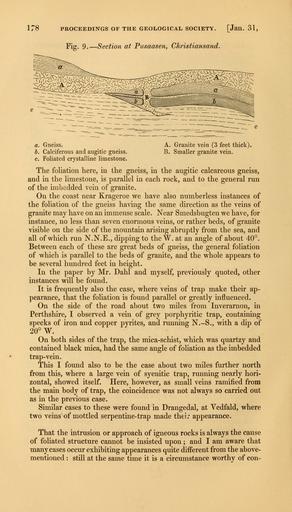MAKE A MEME
View Large Image

| View Original: | The_Quarterly_journal_of_the_Geological_Society_of_London_(12711601973).jpg (1828x3200) | |||
| Download: | Original | Medium | Small | Thumb |
| Courtesy of: | commons.wikimedia.org | More Like This | ||
| Keywords: The Quarterly journal of the Geological Society of London (12711601973).jpg 178 PROCEEDINGS OF THE GEOLOGICAL SOCIETY Jan 31 <br> Fig 9 ” Section at Pusaasen Christiansand <br> i g gpg gp ipi <br> a Gneiss <br> b Calciferous and augitic gneiss <br> c Foliated crystalline limestone <br> A Granite vein 3 feet thick <br> B Smaller granite vein <br> The foliation here in the gneiss in the augitic calcareous gneiss <br> and in the limestone is parallel in each rock and to the general run <br> of the imbedded vein of granite <br> On the coast near Krageroe we have also numberless instances of <br> the foliation of the gneiss having the same direction as the veins of <br> granite may have on an immense scale Near Smedsbugten v\ e have for <br> instance no less than seven enormous veins or rather beds of granite <br> visible on the side of the mountain arising abruptly from the sea and <br> all of vvrhich run N N E dipping to the W at an angle of about 40° <br> Betv een each of these are great beds of gneiss the general foHation <br> of which is parallel to the beds of granite and the whole appears to <br> be several hundred feet in height <br> In the paper by Mr Dahl and myself previously quoted other <br> instances will be found <br> It is frequently also the case where veins of trap make their ap- <br> pearance that the foliation is found parallel or greatly influenced <br> On the side of the road about two miles from Inverarnon in <br> Perthshire I observed a vein of grey porphyritic trap containing <br> specks of iron and copper pyrites and running N -S with a dip of <br> 20° W <br> On both sides of the trap the mica-schist which was quartzy and <br> contained black mica had the same angle of foliation as the imbedded <br> trap-vein <br> This I found also to be the case about two miles further north <br> from this where a large vein of syenitic trap running nearly hori- <br> zontal showed itself Here however as small veins ramified from <br> the main body of trap the coincidence was not always so carried out <br> as in the previous case <br> Similar cases to these were found in Drangedal at Vedfald where <br> two veins of mottled serpentine-trap made their appearance <br> That the intrusion or approach of igneous rocks is always the cause <br> of foliated structure cannot be insisted upon ; and I am aware that <br> many cases occur exhibiting appearances quite diiferent from the above- <br> mentioned still at the same time it is a circumstance worthy of con- 35614750 110213 51125 Page 178 Text v 11 http //www biodiversitylibrary org/page/35614750 1855 Geological Society of London Biodiversity Heritage Library The Quarterly journal of the Geological Society of London v 11 1855 Geology Periodicals Smithsonian Libraries bhl page 35614750 dc identifier http //biodiversitylibrary org/page/35614750 smithsonian libraries Information field Flickr posted date ISOdate 2014-02-23 Check categories 2015 August 26 CC-BY-2 0 BioDivLibrary https //flickr com/photos/61021753 N02/12711601973 2015-08-26 20 55 16 cc-by-2 0 PD-old-70-1923 The Quarterly journal of the Geological Society of London 1855 Photos uploaded from Flickr by Fæ using a script | ||||